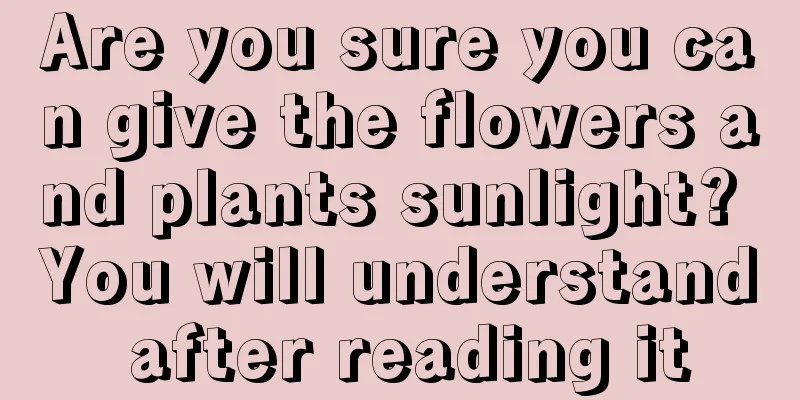Are you sure you can give the flowers and plants sunlight? You will understand after reading it

Long-term exposure to the sunSome flower lovers simply throw their flowers and plants outside and leave them there, especially in the hot summer, without even any shade. This behavior is highly undesirable. Of course, plants that particularly like sunlight, such as jasmine and gardenia, can still tolerate it. Symptoms that may occur: Yellowing, blackening, or reddening of leaf tips Although plants like light, it does not mean that they like all light. Too strong light will inevitably cause damage to plants! The leaves of plants are the most obvious sign of sunburn! Solution:Sunburned leaves cannot recover, so move the sunburned plants to a cool place, or place the plants directly indoors away from sunlight. will already Remove the sunburned leaves, maintain them normally, and wait for the plant to grow new leaves . (Author: Tianjian Mi Tuan Source: Succulent Plant Bar) (Author: Quiet Heavenly Palace Source: Green Radish World Bar) As shown in the last picture, almost all the leaves are sunburned, so we can only put it in a cool place and wait for it to slowly grow new leaves and replace the old leaves. (Author: candy2 by the ear Source: Succulent Plants Bar) Long-term shadingPlants cannot grow without sunlight. Only under light can they carry out photosynthesis and produce the nutrients needed for plant growth. Long-term shading will inevitably inhibit plant growth. Common symptoms: elongation Flower lovers who have grown succulents should all know this phenomenon, right? This phenomenon is not unique to succulents. Any plant that does not receive sufficient sunlight for a long time will easily grow thin and tall, and look like it is about to break! For example, the daffodils in the picture below have thin and long leaves, which are easy to fall over when they grow up. If they are not dealt with, the second picture will be the final result... Solution:1. Get more sun exposure. This is the most convenient way to solve the problem of excessive growth. 2. Topping. If your plant has grown very tall, just topping it. Topping can suppress the apical dominance of the plant and promote branching! Look at the picture below! (Author: Chu Shi Source: Zhihu) (Source: Baidu Knows) Long-term non-rotationPlants have phototropism. What does phototropism mean? It means that plants will unconsciously spread to places where they can be exposed to sunlight. For example, the plant in the picture below is bent 90°, which is caused by phototropism! Common symptoms: The plant becomes crooked Nowadays, most flower lovers probably place their plants on balconies, windows, or bay windows, right? In these locations, due to the obstruction of the house, some parts of the plant will inevitably not be able to get sunlight, and the part that can get sunlight will continue to extend to the place where the sun can get sunlight. Finally, what appears in front of you is a crooked Kalanchoe... For example, the Kalanchoe in the picture below Solution:Rotate the pot of the Kalanchoe once a week or so so that it can get sunlight evenly. (Author: bjayul Source: Kalanchoe Bar) (Author: Chen Meihuan Source: Luohu Education Network Blog) Sunbathing through the glassGlass can block most of the ultraviolet rays in the light, and ultraviolet rays are one of the important factors that inhibit the growth of plants. Therefore, sunbathing through glass may also cause leggy growth. Common symptoms: elongation It's not so bad in winter because the temperature is relatively low and the growth of plants is small, so there is no impact from the glass. However, in spring and summer, which are the growing seasons for plants, the plants grow rapidly and cannot receive ultraviolet rays through the glass. The plants will grow thin and long, especially the sun-loving plants. Solution:In spring, summer, autumn and other seasons, it is best not to expose the flowers to the sun through the glass. Move the flowers and plants outside, or open the balcony windows to receive a few hours of pure sunlight every day. Note: shade is required in summer! |
<<: Are you buying and caring for New Year flowers correctly?
>>: How to propagate the bright grass
Recommend
How to grow ginger to get high yield?
Ginger has strong adaptability and can be found g...
Which month is the best to sow water spinach?
Water spinach is popular for its crisp taste. As ...
How to plant ginger in pots after it sprouts
1. Cut into small pieces Cut the sprouted ginger ...
Where is the best place to plant the velvet flower tree? Is it good to plant it at the gate?
Places where velvet trees are planted The velvet ...
Planting methods and techniques of four-season strawberries
1. Planting time Four-season strawberries are gen...
The Complete Guide to Water-Grown Flowers of Ornamental Pineapples
Hydroponic techniques for pineapples 1. The above...
What is the best season to grow strawberries?
Currently popular on the market are all-season st...
When is the best time to sow Verbena seeds?
Verbena seeds sowing time Verbena is not very dem...
How to grow gladiolus
1. Lighting It likes light very much and should b...
The difference between gentian and gentian
1. Difference of blades The leaves at the base of...
Is the red Bianhua poisonous? Is the red Bianhua precious?
1. Is it poisonous? Red spider lily is poisonous....
How to grow hydrangea
Soil selection In early spring, move the hydrange...
Introduction to Houttuynia cordata, how to propagate Houttuynia cordata
1. Morphological characteristics The stem of Hout...
When is the best time to repot jasmine and what should be paid attention to when repotting
Jasmine repotting time Jasmine needs to be repott...
Cutting video: Learn how to cut green radish, spider plant, and pennywort, 1 pot can become 100 pots
Video of cuttings of Chlorophytum comosum and Pot...









